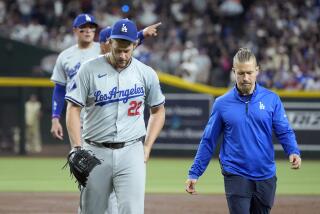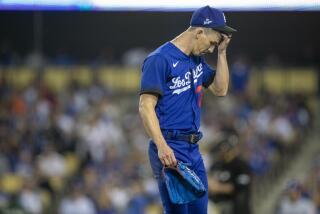A Prospect on the Farm Has Faith
Nothing buoys up a front office and management in baseball like word from down on the farm that a new pitching phenom is doing marvelously, filling the ballpark and striking out the side.
So the Dodgers couldn’t have been happier with the recent news out of Bakersfield and Phoenix.
The word was, they had this tall, skinny young man, so pale you could see through him, who had this slippery sinkerball, this 90-m.p.h. fastball. Even better, he could put them where he wanted them. He had what the managers like to call “command.”
Best of all, he was a paragon of good habits. A young man with a firm belief in Christianity who didn’t smoke, drink, chew tobacco or curse.
His progress was remarkable. He was pitching in Class A Bakersfield on Thursday and by the following Tuesday, was pitching two leagues higher, for the triple-A Albuquerque Dukes against the Phoenix Whozits.
You could picture the minor league manager in his report to the big club raving over his find and arguing, “Boss! This kid could be pitching for you in the bigs right now! He’s got major league stuff. Everyone down here is overmatched. Why, I could see this guy winning a Cy Young.”
You could see the report concluding, “It’d be nice if he had a catchy handle like Swifty Flynn or Fireball Fagan, but he’s got this jawbreaker of a name I can’t even spell.”
Of course, the pitcher in question wasn’t exactly a green kid. The Dodgers didn’t pick him up in the draft and ship him down to the deep minors for seasoning.
You see, he already was a Cy Young Award winner. The pitcher throwing in Bakersfield and Phoenix was none other than Orel L. Hershiser the fourth, and he was not in the minor leagues to pick out a new pitch but to test a new arm.
Orel L. Hershiser was well on his way to becoming a Dodger legend in the spring of 1990. He had won a Cy Young and had broken one of the most hallowed of all pitching records, the consecutive scoreless-inning streak that had once belonged to such Hall of Famers as Walter Johnson and Don Drysdale. He had almost personally scuttled the New York Mets and Oakland A’s to make the Dodgers 1988 World Series champions.
So, what’s he doing down on the farm in this Year of Our Lord 1991?
Well, for Orel, it began as last season was about to open when he noticed this slight tenderness in his pitching shoulder. As the team came west to open the season, he was inclined to ignore it. He had pitched through that kind of aggravation before.
Orel was what he describes as a “hyper-elastic kind of individual, right close to being double-jointed.” His parts seemed to come loose as he pitched, but they always seemed to snap back together again.
This time, they didn’t. The pain not only got worse, it got unbearable. Also unpitchable.
“I found I could pitch three or four innings at an ERA (earned-run) pace of about 1.0, then, suddenly I would be pitching at an 8.7 rate,” he says.
It was every pitcher’s nightmare. The human elbow was not hinged to throw a curveball or even a sinker. Pitching is always part pain. This was more as if someone had set fire to the shoulder or arranged for a horse to kick it every time he let go of the curve.
Because the rotator cuff, which is to a pitcher what the heel was to Achilles, appeared to have escaped involvement, Orel thought he could pitch through his difficulties. After all, he always had.
Dr. Frank Jobe disabused him. This was not normal springtime adhesions. To put it in non-medical terms, Orel’s shoulder was a mess. He was lucky he could eat with his right arm, never mind pitch with it.
The surgical procedure indicated is too complicated to be simplified but, in sum, if Orel’s shoulder sheath had to be removed en masse, Orel would have to start learning to do things with his left hand. Only a revolutionary surgical technique that could, in effect, repair the shoulder tears individually, with bone anchors and scar tissue, could restore any effectiveness to the arm.
But since Jobe was the one who had put 167 more victories into the left arm of Tommy John long after medical wisdom had dictated he should have trouble even opening letters with it, Hershiser was encouraged.
But that was Tommy John. His operation was almost the most successful of its kind ever. Would Orel’s be that good?
Rehabilitation is a long tedious process, and that is why Orel is only now re-learning to grip a curveball and trying not to walk anybody in minor league ballparks far from the high-stakes tables of Dodger or Shea stadiums.
More than medical science is sustaining Orel. An athlete who falls to his knees on the pitcher’s mound right after getting the final out in a World Series, a pitcher who hums hymns as he mows down the batting order in playoffs, Orel has more than surgery going for him. He has faith.
“I wasn’t always this way,” he acknowledges today. “I used to see these religious nuts parading around, and I thought they were loonies. I thought, ‘Let me outta here!’ ”
His conversion wasn’t anything as dramatic as being struck down on the road to Damascus. It didn’t even involve finding a new slider in his repertoire of pitches.
“I just began to read the Bible and it was like a light went on in my life,” he says.
It has sustained him in his agony.
“There is nothing like being on the sidelines for a year and a half to rearrange the priorities in your life. I remember thinking, ‘Well, the worst that can happen is, you still have your family and your loved ones and your faith, only you don’t have to perform in front of 50,000 people every night.’ ”
You don’t have to get Will Clark out with the bases loaded or Jose Canseco out with the Series on the line.
“You do have to wait till the scar tissue forms and the body heals itself,” he says.
And he adds: “I didn’t think God brought me to this point, 32 years old, just to stop the story.”
That is why he was back pitching in the minors, first at Bakersfield, then in an Albuquerque uniform again for the first time since he outgrew it nine years ago.
“I pitched five innings, no walks, no runs, two hits, threw 44 pitches, 32 strikes for Bakersfield, then pitched five innings, five hits, no walks, no runs, 68 pitches for Albuquerque,” he says. “I know it’s not the major leagues but the plate is 60 feet 6 inches (away) and the man has a bat on his shoulder.”
Sounds like a hot prospect to the Dodgers. After all, when a man jumps two classifications in a week and still pitches a shutout, you’d better find a spot on the roster for him. Orel only hopes when he does get back on the mound there, the hymn he hums won’t be “Nearer My God to Thee.”
* OREL UPDATE: Orel Hershiser continues his minor league rehabilitation in a Class-A game at Bakersfield. C11
More to Read
Are you a true-blue fan?
Get our Dodgers Dugout newsletter for insights, news and much more.
You may occasionally receive promotional content from the Los Angeles Times.






